|
My Canonist friend gave me this lens for testing, and I gave it a speedy test to check its optical quality and verify the rumors regarding this lens. This is Canon’s latest lens (as to this test’s date – 21.1.2006), and Canon designed a lens that will cover as wide a range as possible while maintaining a fixed aperture throughout this range, F:4.
This lens has a very large zoom range – 4.3 times – and is supposed to be a professional L family lens. Trying to cover such a range with a fixed aperture of 2.8 is optically very difficult, would cost a fortune, and would probably be very heavy. A Nikon lens of similar zoom range would be the Nikon 17-55/2.8, which was initially designed to be a DX lens and its zoom range is 3.2 times. A lens of similar range is the Tamron 28-105/2.8, which is an expensive lens with quite a mediocre performance. The Canon 24-105 /4 lens is also expensive although the maximal aperture is relatively small. This lens costs $1,250 in the USA, while the Nikon costs around $1,200 and the Tamron $800 before a chunky rebate of $200. A few technical details regarding the Canon lens, as compared to the similar Nikon lens: It is constructed of 18 elements in three groups (a very complicated structure), which is far more complicated than the Nikon lens (constructed of 14 elements in 10 groups). On the other hand, the Nikon lens has 3 aspheric elements that can replace a large number of regular elements and has in addition three ED elements.
Canon’s spec states that the lens includes UD elements (similar to ED) and aspheric elements but does not reveal the quantity of each. One can find a very close resemblance in the design of these two lenses. The lens offers IS and USM while the Nikon lens offers only AFS with no VR. It is not a light-weight lens, 670gr, which is felt when holding it. But still, it is lighter than the Nikon lens, which weighs 750gr. both lenses are similar in size. The lens can shoot at close range – up to 45cm, and provides an enlargement factor of 0.23, as compared to the Nikon lens, which while capable of shooting at a slightly shorter range (up to 36cm), provides an enlargement factor of only 0.2, due to its short maximal focal length. The filter diameter (77mm) and the minimal aperture (22) are identical for both lenses. The lens has 8 rounded aperture leaves, in comparison to the 9 rounded leaves on the Nikon. Why am I comparing it to this Nikon? First, because by their structure and their cost, they belong to the same league, and if we install a x1.4 teleconverter on the Nikon lens, we will get a lens with a maximal aperture of 4 and a focal length of approximately 24-77mm.
There are several other similar parameters, as we will see later on. The field test was performed with Canon 20D DSLR camera. The lens focuses rapidly and the IS worked well. The pictures where taken in RAW format and converted to JPEG, not at the maximal resolution – but enough for reaching conclusions.
So, this is how the lens looks like: All the tests were performed at fully wide-open aperture - since this is a real and an aggressive test for high quality lenses.
Each lens becomes sharp when closing it to aperture 8 and the difference between lenses can be easily revealed when shot at a wide-open aperture. It passed the sharpness test magnificently, both in its 24mm state and in its 105mm state. This lens has excellent sharpness with an open aperture. The following is its 24mm state: 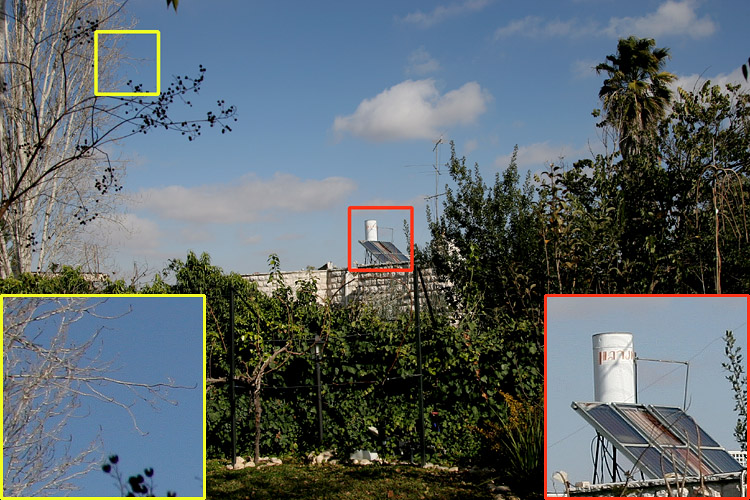 | | Model: Canon EOS 20D Exposure Time: 1/1600sec F Number: 4 Focal Length: 24mm Exposure Program: Aperture priority Exposure Bias Value: 0 ISO Speed Ratings: 100 Metering Mode: Partial White Balance: Auto white balance Flash: Flash did not fire, compulsory flash mode Date Taken: 2006:01:21 13:18:33 Color Space: sRGB |
The sharpness is excellent both in the center and at the edges. It is also sharp in its 105mm state as you can see in the following picture: 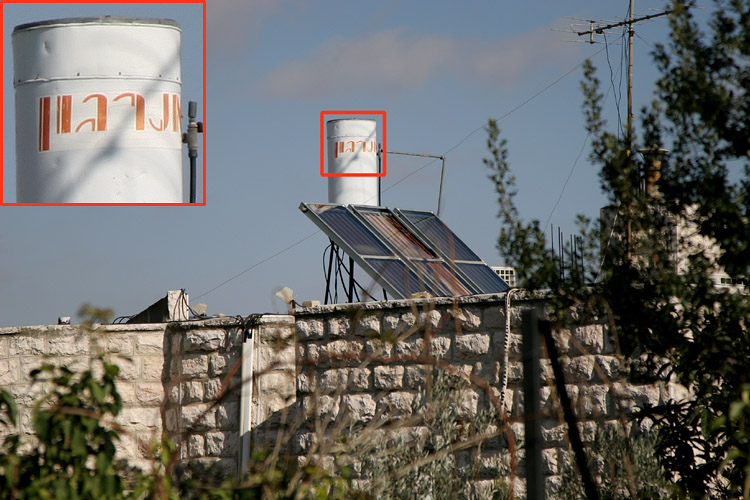 | | Model: Canon EOS 20D Exposure Time: 1/2000sec F Number: 4 Focal Length: 105mm Exposure Program: Aperture priority Exposure Bias Value: 0 ISO Speed Ratings: 100 Metering Mode: Partial White Balance: Auto white balance Flash: Flash did not fire, compulsory flash mode Date Taken: 2006:01:21 13:18:35 Color Space: sRGB |
The microcontrast rendition integrates into the perception of sharpness – this was tested under different lighting conditions. In the first picture you can see that the lens maintains excellent microcontrast although the right hand side of the picture exhibits large areas of very bright light. All the fine details of the tree bark seem to “jump” out of the picture:  | | Model: Canon EOS 20D Exposure Time: 1/320sec F Number: 4 Focal Length: 105mm Exposure Program: Aperture priority Exposure Bias Value: 0 ISO Speed Ratings: 100 Metering Mode: Partial White Balance: Auto white balance Flash: Flash did not fire, compulsory flash mode Date Taken: 2006:01:21 13:19:35 Color Space: sRGB |
Since this went well, I tried the lens against an extremely bright light, a real challenge – that should not show the lens’s best performance, and even in this test the fine details of the lamppost are impressively revealed although there is a bright back light: 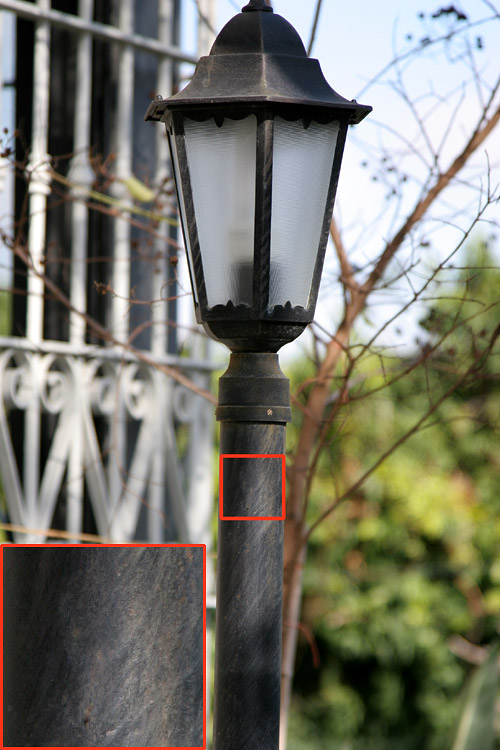 | | Model: Canon EOS 20D Exposure Time: 1/320sec F Number: 4 Focal Length: 105mm Exposure Program: Aperture priority Exposure Bias Value: 0 ISO Speed Ratings: 100 Metering Mode: Partial White Balance: Auto white balance Flash: Flash did not fire, compulsory flash mode Date Taken: 2006:01:21 13:20:53 Color Space: sRGB |
The lens produces neutral colors, with a slight tendency toward the warm tones. It reproduces skin tones properly. I cannot show the results in this aricle, since the people photographed did not give their consent. Nonetheless, it can handle difficult lighting conditions and produce well-saturated tones – the red practically “screams”:  | | Model: Canon EOS 20D Exposure Time: 1/800sec F Number: 4.5 Focal Length: 105mm Exposure Program: Aperture priority Exposure Bias Value: 0 ISO Speed Ratings: 100 Metering Mode: Partial White Balance: Auto white balance Flash: Flash did not fire, compulsory flash mode Date Taken: 2006:01:21 13:17:13 Color Space: sRGB |
When shooting elements of similar tone (different shades of green), it separates them properly without a problem:  | | Model: Canon EOS 20D Exposure Time: 1/400sec F Number: 4.5 Focal Length: 105mm Exposure Program: Aperture priority Exposure Bias Value: 0 ISO Speed Ratings: 100 Metering Mode: Partial White Balance: Auto white balance Flash: Flash did not fire, compulsory flash mode Date Taken: 2006:01:21 13:17:16 Color Space: sRGB |
It produces a bokeh that is almost perfect, and if the aperture would have an extra leaf or two, creating a perfect circle, it would indeed be perfect. What it has is quite sufficient for taking portraits and it deals with this area of photography very well: 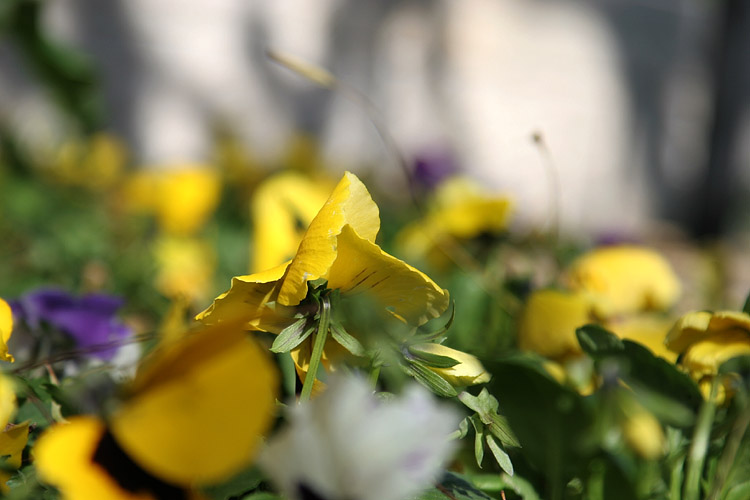 | | Model: Canon EOS 20D Exposure Time: 1/800sec F Number: 4.5 Focal Length: 105mm Exposure Program: Aperture priority Exposure Bias Value: 0 ISO Speed Ratings: 100 Metering Mode: Partial White Balance: Auto white balance Flash: Flash did not fire, compulsory flash mode Date Taken: 2006:01:21 13:17:35 Color Space: sRGB |
The lens has only slight CA (color aberrations), which are evident at the edges or at extreme exposure conditions. The CA at the edges is certainly within the accepted range: 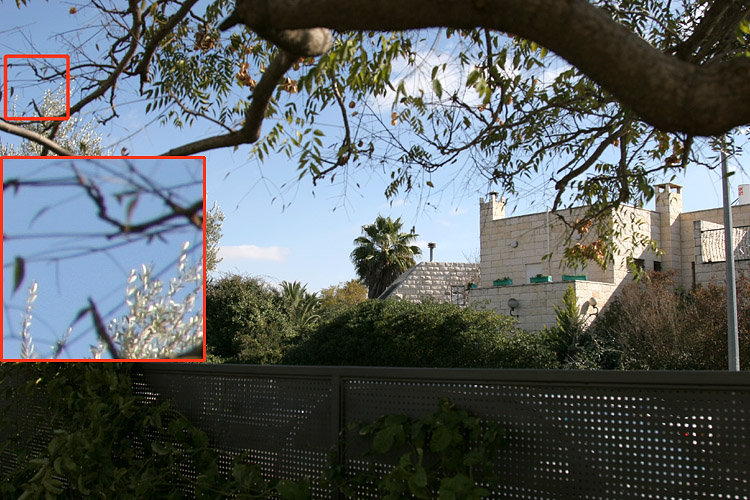 | | Model: Canon EOS 20D Exposure Time: 1/1000sec F Number: 4 Focal Length: 24mm Exposure Program: Aperture priority Exposure Bias Value: 0 ISO Speed Ratings: 100 Metering Mode: Partial White Balance: Auto white balance Flash: Flash did not fire, compulsory flash mode Date Taken: 2006:01:21 13:18:27 Color Space: sRGB |
An extreme overexposure condition enhances the marginal problems, but this can be found in almost every lens: 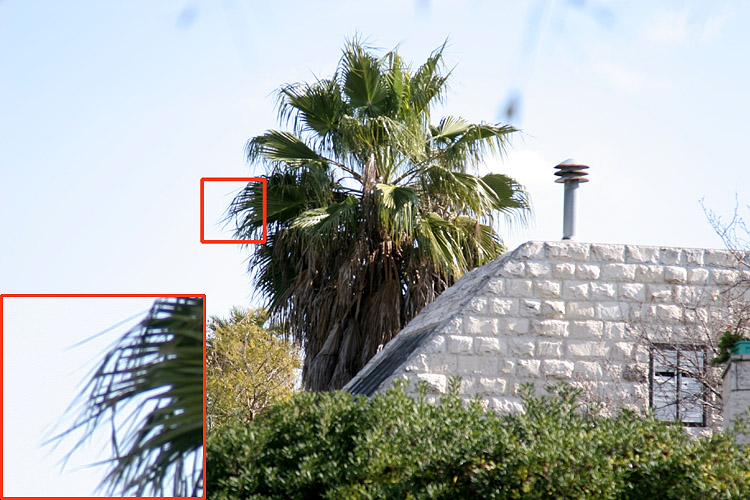 | | Model: Canon EOS 20D Exposure Time: 1/320sec F Number: 4 Focal Length: 105mm Exposure Program: Aperture priority Exposure Bias Value: 0 ISO Speed Ratings: 100 Metering Mode: Partial White Balance: Auto white balance Flash: Flash did not fire, compulsory flash mode Date Taken: 2006:01:21 13:18:23 Color Space: sRGB |
In general, one can state that the lens is CA free for all practical purposes. The only problem left – the one that is reported in all the literature concerning this lens – is the problem of flare. Yes, one can say that the flare problem exists, but it is no different than flare problems of other lenses, including Nikon’s 17-55, which suffers the same difficulty. I caught the sun at the frame edges and the flare is certainly reasonable for this picture. It is located around the sun and not overly smudged across the frame:  | | Model: Canon EOS 20D Exposure Time: 1/8000sec F Number: 4 Focal Length: 24mm Exposure Program: Aperture priority Exposure Bias Value: 0 ISO Speed Ratings: 100 Metering Mode: Partial White Balance: Auto white balance Flash: Flash did not fire, compulsory flash mode Date Taken: 2006:01:21 13:18:57 Color Space: sRGB |
On the other hand, when the sun does not appear directly in the frame, but close on the outside, the flare can “steal” its way into the frame (just as it does with the Nikon 17-55) and one needs a sun shade on sunny days like this one: 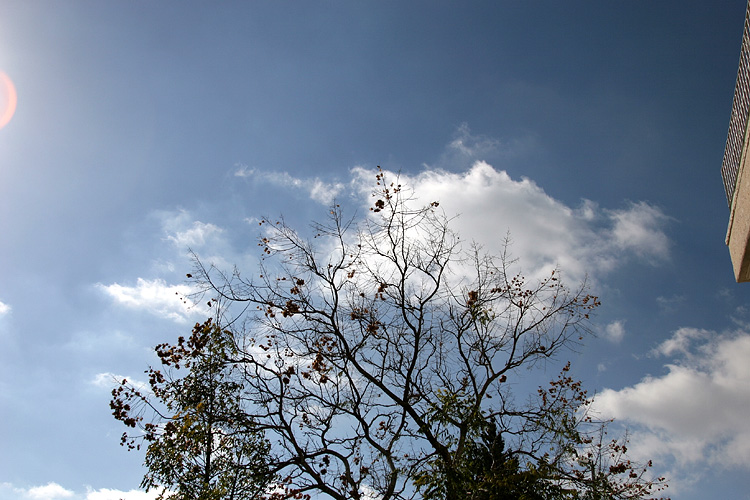 | | Model: Canon EOS 20D Exposure Time: 1/4000sec F Number: 4.5 Focal Length: 24mm Exposure Program: Aperture priority Exposure Bias Value: 0 ISO Speed Ratings: 100 Metering Mode: Partial White Balance: Auto white balance Flash: Flash did not fire, compulsory flash mode Date Taken: 2006:01:21 13:17:57 Color Space: sRGB |
I managed to “fish” the flare that is discussed so much on the Web, but in my opinion, a sun shade and a bit of caution will completely prevent flare from appearing:  | | Model: Canon EOS 20D Exposure Time: 1/2000sec F Number: 4.5 Focal Length: 24mm Exposure Program: Aperture priority Exposure Bias Value: 0 ISO Speed Ratings: 100 Metering Mode: Partial White Balance: Auto white balance Flash: Flash did not fire, compulsory flash mode Date Taken: 2006:01:21 13:17:55 Color Space: sRGB |
I believe that these phenomena are the remains of a real problem that appeared in the first production series of this lens, and that Canon fixed this problem. I want to put a limit on the results of my testing, since I did not try this lens on an FF camera –for which it is intended (as opposed to the Nikon 17-55, which is a DX fit only for cameras with an APS sensor).
Altogether, I do not expect that on an FF camera the lens will show different results in its sharpness, in its microcontrast, in the bokeh and in its tones. But there could be a difference in its CA and its tendency to flare.
To sum it all up, I can say that here we have a very good lens optic-wise, which covers a very large and useful range (especially on FF cameras), it focuses rapidly with a useful and enhanced IS under bad lighting conditions. Its small problems are marginal and meaningless for all practical purposes. Canon did a very good optical job – and I recommend it to anyone who has the means to buy it. |





